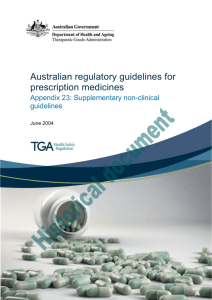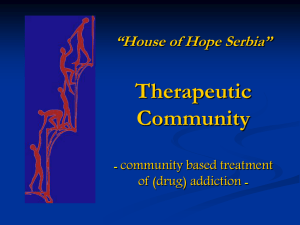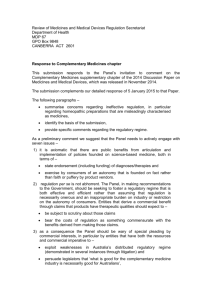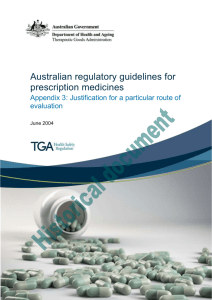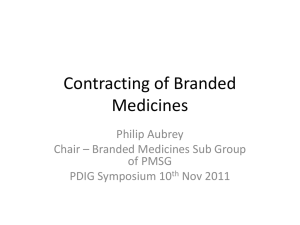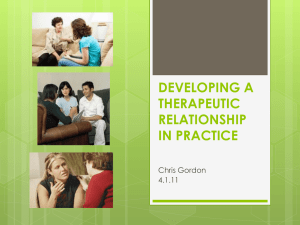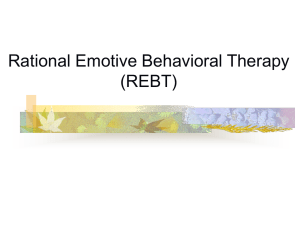Introduction to the TGA (Microsoft PowerPoint,7.98Mb)
advertisement
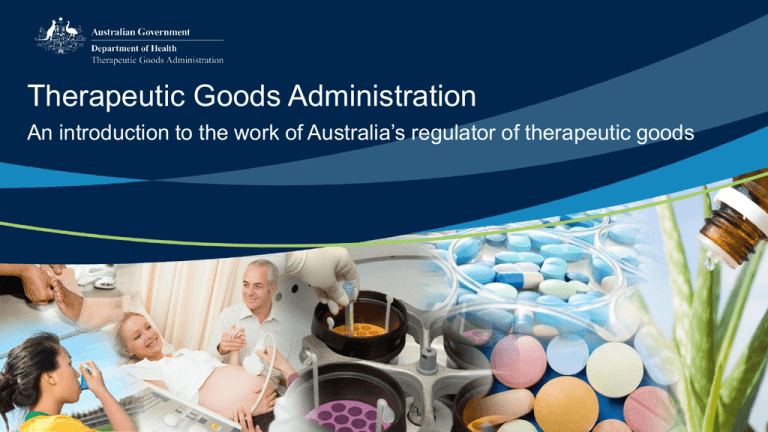
Therapeutic Goods Administration An introduction to the work of Australia’s regulator of therapeutic goods Overview • Why do we need regulation? • The benefit versus risk approach • Who is Australia’s regulator? • • How the TGA operates Activities conducted before and after a product is released to the market • Who works at the TGA • Australia New Zealand Therapeutic Products Agency • Therapeutic goods • Other education modules • Australian Register of Therapeutic Goods • TGA’s mission 2 Why do we need regulation? Australian doctor William McBride alerted the world to the dangers of thalidomide in the 1960s which triggered the need for an Australian regulator of therapeutic goods. “In recent months I have observed that the incidence of multiple severe abnormalities in babies delivered of women who were given the drug thalidomide (‘Distival’) during pregnancy, as an anti-emetic or as a sedative, to be almost 20%.” 3 Who is Australia’s regulator? • The Therapeutic Goods Administration was established in 1990 to “safeguard and enhance the health of the Australian community through effective and timely regulation of therapeutic goods” Health Safety Regulation • It provides a national system of controls relating to the quality, safety, efficacy and timely availability of therapeutic goods used in, or exported from, Australia 4 TGA – how we operate • We are part of the Australian Government Department of Health • Every decision the TGA makes is based on the Therapeutic Goods Act 1989 • Main offices in Canberra – satellite offices in Sydney, Melbourne, Adelaide and Brisbane • Operations are primarily cost recovered (98%) industry pays fees for making applications and annual charges for products they are responsible for 5 Who works at the TGA? Approximately 750 staff made up of: Biomedical scientists Engineers Physiotherapists Medical officers Pharmacists Nurses Toxicologists Lawyers Nutritionists Dieticians Scientists Administrative staff 6 Under the Therapeutic Goods Act 1989, therapeutic goods are defined as: Products for use in humans in connection with • preventing, diagnosing, curing or alleviating a disease, ailment, defect or injury • influencing, inhibiting or modifying a physiological process • testing the susceptibility of people to a disease or ailment • influencing, controlling or preventing conception • testing for pregnancy • replacing or modifying parts of the anatomy All these products are therapeutic goods! 7 Types of therapeutic goods Medicines and blood products • • • • prescription medicines over the counter medicines complementary medicines blood, blood components and plasma derivatives Medical devices • implants (artificial hips, breast implants) • in-vitro diagnostics (pregnancy tests, blood glucose monitors) • low risk medical devices (bandages, tongue depressors, condoms) Biologicals • human stem cells • tissue-based products (skin and bone) • cell-based products 8 Australian Register of Therapeutic Goods All goods must be entered in the ARTG before they can be supplied in, imported to, or exported from Australia Registered medicines Listed medicines • higher risk medicines that are registered on the ARTG • evaluated for quality, safety and efficacy • Product Information is approved by the TGA • lower risk medicines that are listed on the ARTG • contain pre-approved, low risk ingredients • can only make limited claims and cannot imply that they will be useful in the treatment or prevention of serious illnesses • All prescription medicines • Most over-the-counter medicines • Some complementary medicines • Some over-the-counter medicines • Most complementary medicines Medical devices • higher risk devices are evaluated for quality, safety and performance • lower risk devices are not evaluated for performance Devices are classified according to their level of risk, ranging from Class I (lower risk) such as urine collection bottles to Class III (higher risk) such as antibiotic bone cements 9 9 TGA’s mission Health Safety Regulation To safeguard and enhance the health of the Australian community through the effective and timely regulation of therapeutic goods. 10 How do we fulfil this mission? 1 Good Manufacturing Practice or Manufacturing Principles: licensing Australian manufacturers and verifying compliance of overseas manufacturers (see the TGA education module on GMP) 2 Premarket assessments: assessing therapeutic goods for quality and safety (the extent of the assessment depends on the type of product and level of associated risk), and for higher risk products also for efficacy or performance 3 Postmarket assessments: monitoring of therapeutic goods and enforcement of standards (see the TGA education module on postmarket monitoring) 11 The benefit versus risk approach • No therapeutic good is risk free • The work of the TGA is based on applying scientific and clinical expertise to decision making • We ensure that the benefits outweigh any risks associated with the use of medicines, medical devices and other therapeutic goods 12 Premarket assessment The level of assessment is based on how much risk the product poses Low risk Products such as complementary medicines and low risk medical devices are assessed for quality and safety High risk Products such as prescription medicines are assessed for quality, safety and efficacy High risk medical devices are assessed for quality, safety and performance For both categories there are manufacturing standards that must be met 13 Postmarket activities Monitoring/Alerts Databases Manufacturing • Monitors claims made in advertisements for therapeutic goods and issues fines and sanctions if they can not be supported • Issues alerts • Records reports of adverse events by consumers, health professionals and industry • Records recall actions • Further inspections of manufacturers of therapeutic goods 14 Australia New Zealand Therapeutic Products Agency • The Australian and New Zealand Governments have agreed to proceed with a joint scheme for regulation of therapeutic goods by 2016 • The creation of a joint regulatory scheme across both countries will safeguard public health and safety, while encouraging economic integration and benefitting industry in both countries • The Australia New Zealand Therapeutic Products Agency will absorb the current regulators; Australia’s Therapeutic Goods Administration and New Zealand’s Medsafe Medsafe TGA ANZTPA 15 Other education modules include: Medicines Biologicals Medical devices Postmarket monitoring Good Manufacturing Practice 16
